by Crystal Lair
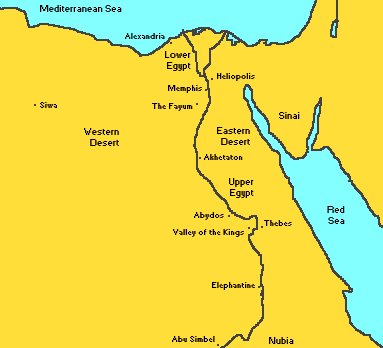
Map of Ancient Egypt
There were four remarable women who became rulers of one of the most famous empires in the ancient world at a time when only men ruled, they were: Nitocris, Nefrusobek, Hatshepsut, and Tewosert. These four remarkable women were all rulers of the greatest land of its time, Ancient Egypt.
The first woman ruler of Ancient Egypt was Nitocris. She was the last ruler of the Sixth Dynasty of the Old Kingdom Period, just before it fell apart in anarchy during the First Intermediate Period. She became ruler of the "Two Lands" after King Pepy II died. Very little is known about her rule, and she took the throne for only a short time. One story about her is that she committed suicide after her brother’s death.

Nefru-Sobek’s name appears on the Temple of Karnak
The second women Pharaoh was Nefru-Sobek, she was the eighth ruler of the Twelfth Dynasty. She was the daughter of Amenmhet III. She succeeded Amenmhet IV, who was also her half-brother. Although once again very little is known of her five year rule, she was one of the only women to have actually had her name placed in the "official" kings lists. Her name is carved on the walls of the Karnak temple, and her name is on the King’s List at Turin. A sphinx and three statues of her were found in Lower Egypt.
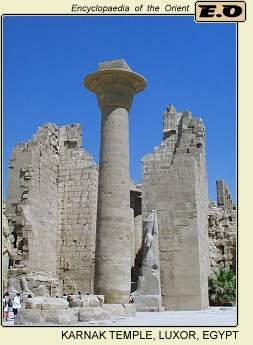
Buried in the Temple of Karnak were many statues of Hatshepsut
The third, and most famous of the women pharaohs is Hatshepsut. She was the daughter of Queen Ahmose and King Tutmose I. She became the longest ruling women Pharaoh. In the beginning, she was only Queen Regent for her stepson, Thutmose III. However, two years into his rule she was crowned joint ruler. She stayed in power for 20 years. They let her be Pharaoh because, as depicted on the funerary walls at Deir el Bahir, they believed she was the actual child of the Egyptian god Amen-Re. During the time she was in power, she concentrated on expeditions to Byblos for timber, on domestic policy, on trading ventures to the Sinai for turquoise, and on her temples. all though her rule she had many great buildings and monuments built, such as, her two obelisks and her great temple at the entrance of the Valley of the Kings. Her chief architect Senenmut helped her on her building projects. She was one of the greatest rulers of Egypt. She died in 1457 BCE, and Thutmose III became sole ruler.
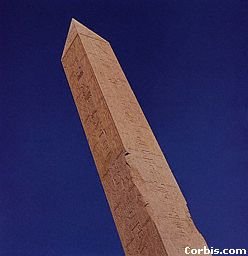
Hatshepsut’s oblisk
The last women Pharaoh was Tewosert. She was the last ruler of the 19th Dynasty. She was the widow of Seti. For the first four years of her rule she was Queen Regent for Sipath, who suddenly disappeared in the fourth year of his rule. She actually only ruled as Pharaoh for two years after this. Although she only ruled a very brief time, when she died they built a very beautiful tomb for her, but it was later torn down by King Sethnakhte, the first ruler of the 20th dynasty.
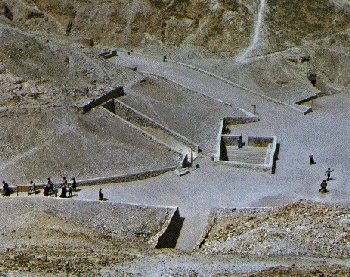
Valley of the Queens where Tewosert's tomb was located
There were many other Queens of Egypt that were great and important, but didn’t rule in their own right like Nitocris, Nefrusobek, Hatshepsut, and Tewosert. These four women stepped out of the shadows of their male counterparts, and seized power in their own rights. They left behind great monuments and works, and even though most have been ruined, the ones that still stand are impressive. For instance, the Obelisk of Hatshepust still stands, even though many later male rulers have tried to erase her name from history, she still remains. Her great temple still stands at the entrance to the Valley of the Kings. And recently, many statues of her have been unearth where they had been buried for centuries.
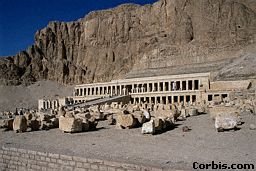
Hatshepsut’s temple
At some point in time, all these four women changed the history of Egypt, and though some of their reigns were short, and many people have tried to erase their memory, their names live on.
Sources:Bunson, Margaret. A Dictionary of Ancient Egypt. New York: Oxford University Press, 1991
David, Antony and Rosalie. A Bibliographical Dictionary of Ancient Egypt. Norman: University of Oklahoma Press, 1992
"Hatshepsut" World Encyclopedia, Volume 16, 1989 edition
Picture #1 - "Map of Ancient Egypt" from: http://www.mcn.net/~jimloy/map.html
Picture #2 - "Nefru-Sobek’s name appears on the Temple of Karnak" from: http://www.tssphoto.com/potd/pd41/pd031299.html
Picture #3 - "Buried in the Temple of Karnak were many statues of Hatshepsut" from: http://lexicorient.com
Picture #4 - "Hatshepsut’s oblisk" from: http://search.corbis.com/default.asp?i=10141137&vID=1&rID=105
Picture #5 - "Valley of the Queens where Tewosert's tomb was located" from: http://sun.kent.wednet.edu/curriculum/soc_studies/Egypt/kings.html
Picture #6 - "Hatshepsut’s temple" from: http://www.corbis.com/